Miss X
RSP 10999
Grower: DigiPath Labs
General Information
- Sample Name
- F20161221-01-6
- Accession Date
- August 28, 2017
- Reported Plant Sex
- Female
- Report Type
- StrainSEEK v2 3.2Mb
- DNA Extracted From
- Unknown
The strain rarity visualization shows how distant the strain is from the other cultivars in the Kannapedia database. The y-axis represents genetic distance, getting farther as you go up. The width of the visualization at any position along the y-axis shows how many strains there are in the database at that genetic distance. So, a common strain will have a more bottom-heavy shape, while uncommon and rare cultivars will have a visualization that is generally shifted towards the top.
Chemical Information
Cannabinoid and terpenoid information provided by the grower.
Cannabinoids
- THC + THCA
- 27.%
- CBD + CBDA
- 0.038%
- THCV + THCVA
- 0.%
- CBC + CBCA
- 0.%
- CBG + CBGA
- 0.713%
- CBN + CBNA
- 0.079%
Terpenoids
- α-Bisabolol
- 0.003%
- Borneol
- n/a
- Camphene
- 0.02%
- Carene
- 0.%
- Caryophyllene oxide
- 0.%
- β-Caryophyllene
- 0.107%
- Fenchol
- n/a
- Geraniol
- 0.%
- α-Humulene
- 0.124%
- Limonene
- 0.586%
- Linalool
- 0.25%
- Myrcene
- 1.074%
- α-Phellandrene
- n/a
- Terpinolene
- 0.004%
- α-Terpineol
- n/a
- α-Terpinene
- 0.%
- γ-Terpinene
- 0.007%
- Total Nerolidol
- 0.03%
- Total Ocimene
- 0.01%
- α-Pinene
- 0.1%
- β-Pinene
- 0.159%
Genetic Information
- Plant Type
- Type I
File Downloads
The bell curve in the heterozygosity visualization shows the distribution of heterozygosity levels for cannabis cultivars in the Kannapedia database. The green line shows where this particular strain fits within the distribution. Heterozygosity is associated with heterosis (aka hybrid vigor) but also leads to the production of more variable offspring. When plants have two genetically different parents, heterozygosity levels will be higher than if it has been inbred or backcrossed repeatedly.
The ratio of reads mapped to Y-contigs to reads mapped to the whole Cannabis genome (Y-ratios) has been demonstrated to be strongly correlated with plant sex typing. This plot shows the distribution of Y-ratios for all samples in our database which were sequenced with the same method (panel or WGS) as this sample and where this sample falls in the distribution.
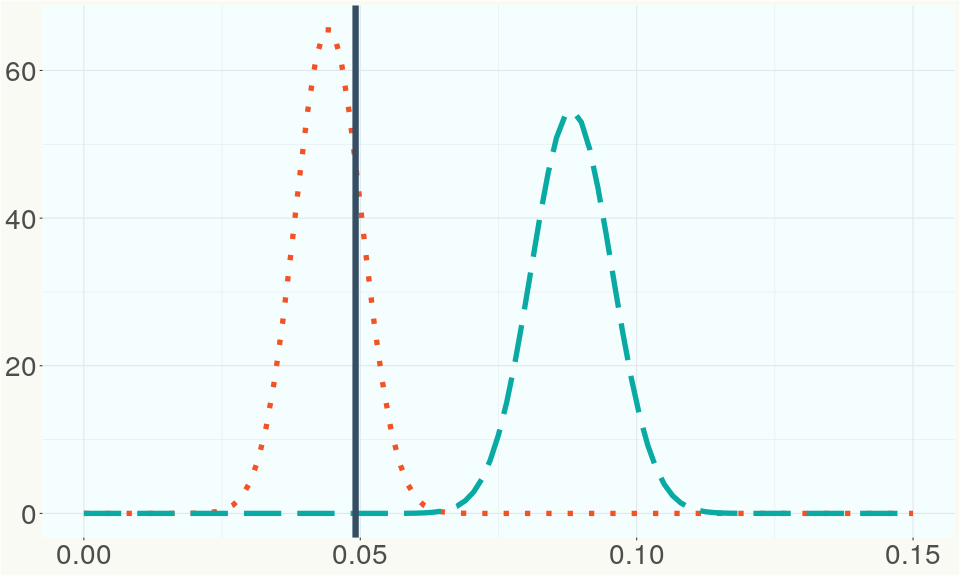
This chart represents the Illumina sequence coverage over the Bt/Bd allele. These are the three regions in the cannabis genome that impact THCA, CBDA, CBGA production. Coverage over the Active CBDAS gene is highly correlated with Type II and Type III plants as described by Etienne de Meijer. Coverage over the THCA gene is highly correlated with Type I and Type II plants but is anti-correlated with Type III plants. Type I plants require coverage over the inactive CBDA loci and no coverage over the Active CBDA gene. Lack of coverage over the Active CBDA and Active THCA allele are presumed to be Type IV plants (CBGA dominant). While deletions of entire THCAS and CBDAS genes are the most common Bt:Bd alleles observed, it is possible to have plants with these genes where functional expression of the enzyme is disrupted by deactivating point mutations (Kojoma et al. 2006).
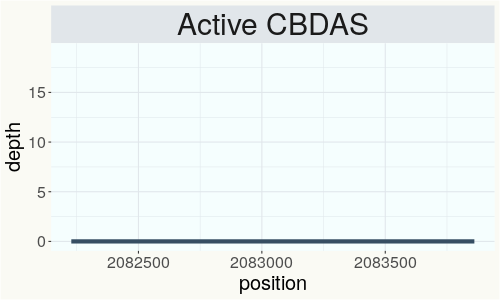
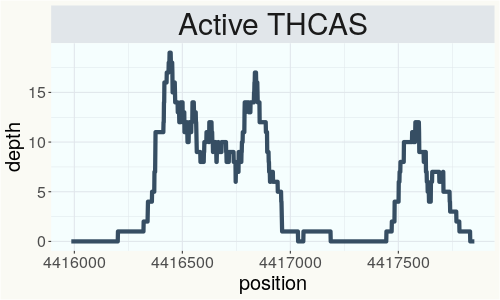
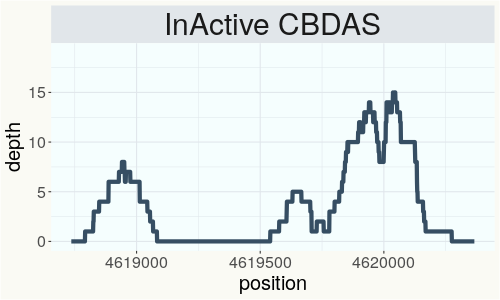
This chart represents the Illumina sequence coverage over the CBCA synthase gene.
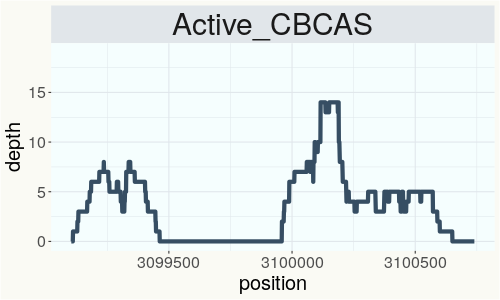
Variants (THCAS, CBDAS, and CBCAS)
No variants to report
Variants (Select Genes of Interest)
| PKSG-2a | c.67T>A | p.Phe23Ile | missense variant | moderate | contig700 | 1945567 | A/T | |
| PKSG-2b | c.31A>T | p.Thr11Ser | missense variant | moderate | contig700 | 1951851 | T/A | |
| PKSG-2b | c.-2_1dupATA | start lost & conservative inframe insertion | high | contig700 | 1951880 | A/ATAT |
|
|
| aPT1 | c.406A>G | p.Ile136Val | missense variant | moderate | contig121 | 2839605 | A/G |
Nearest genetic relatives (All Samples)
- 0.171 Lift (RSP11378)
- 0.171 Electra (RSP11366)
- 0.173 Serious Happiness (RSP10763)
- 0.180 Doug s Varin (RSP11243)
- 0.182 Badger (RSP11614)
- 0.189 Durban Poison #1 (RSP10996)
- 0.193 Joy (RSP11380)
- 0.193 Rest (RSP11377)
- 0.196 Trump x Trump (RSP11466)
- 0.198 Blueberry Cheesecake (RSP10684)
- 0.204 Durban Poison #1 (RSP11013)
- 0.204 Wedding Pie (RSP11745)
- 0.204 Green Crack (RSP12099)
- 0.205 White Label 2 (RSP11337)
- 0.206 Lemon G13 (RSP11465)
- 0.208 Blue Dream (RSP11004)
- 0.208 Strawberry (RSP12095)
- 0.208 Domnesia (RSP11184)
- 0.209 Strawberry Cough (RSP11356)
- 0.212 Cheese (RSP10460)
Most genetically distant strains (All Samples)
- 0.419 JL yellow (RSP11075)
- 0.410 JL 3rd Gen Mother (RSP11214)
- 0.404 JL 3rd Gen Mother (RSP11197)
- 0.390 Cherry Blossom (RSP11323)
- 0.389 Chematonic -Cannatonic x Chemdawg- (RSP11394)
- 0.381 80E (RSP11213)
- 0.380 Cherry Blossom (RSP11298)
- 0.379 Chem 91 (RSP11185)
- 0.378 Tanao Sri -46- (RSP11486)
- 0.377 Feral (RSP11205)
- 0.377 IUP2 (SRR14708257)
- 0.377 Cherry Blossom (RSP11306)
- 0.375 JL Tent 4 (RSP11491)
- 0.370 Feral (RSP10892)
- 0.364 IUP3 (SRR14708256)
- 0.362 JL 4th Gen 5 (RSP11199)
- 0.361 80E (RSP11211)
- 0.360 Cherry Blossom (RSP11309)
- 0.359 Feral (RSP10890)
- 0.358 Brunswick High (RSP11164)
Nearest genetic relative in Phylos dataset
- Overlapping SNPs:
- 27
- Concordance:
- 20
Nearest genetic relative in Lynch dataset
- Overlapping SNPs:
- 5
- Concordance:
- 5
Blockchain Registration Information
- Transaction ID
-
e99b0daaa75b21e0
1129c299a7b176f4 30ce285016b846d9 36039a3fa8824316 - Stamping Certificate
- Download PDF (865.8 KB)
- SHASUM Hash
-
e39483bc78bc40e796ff70506bd1b8c1 700bf09a5aea76e5 a8a342dca5f071f2